Are animals the best allies in war?
- Published

Throughout history, animals have proved to be one of the most important allies in war.
But while horses and elephants first fought alongside humans many centuries ago, in modern times humans have also turned to exploding rats and dolphin spies during conflicts.
More recently stray and abandoned dogs from Afghanistan have helped British servicemen deal with the horrors of combat stress in finding solace and companionship.
Take a look at some of the stranger ways that animals have been used by the military.

Bomb-sniffing bees
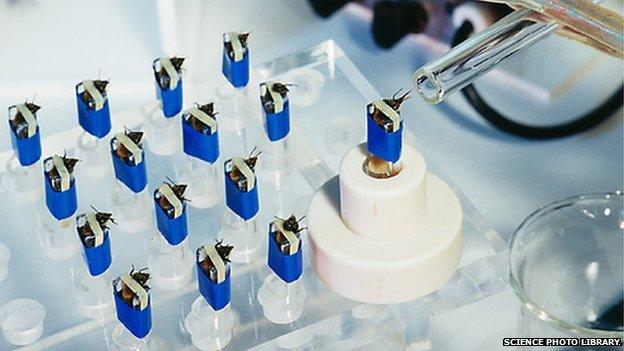
Honeybees are mounted in tiny harnesses within a detection unit
The government has given £250,000 to researchers to test the ability of honeybees to sniff out explosives, external in freight destined for cargo and passenger planes.
Scientists say they can be trained to detect a single type of explosive, narcotic or chemical weapon by being given food each time a particular chemical is passed through the air.
This means that the bee, while mounted in tiny harnesses within a detection unit, can be trained to repeat the action each time it comes into contact with the chemical. This is then recorded by image-detecting software.
Multiple groups can be housed in the same unit, in theory creating a bomb-detection hive of sensor-bees.
The research company Inscentinel has received funding to run a trial.
Norman Carreck, science director of the International Bee Research Association, said: "Bees have an incredibly good sense of smell from long distances.
"There is an established lab technique and bees can be trained to sniff out bombs or explosives, but we need to find sufficient investment."

Parachuting dogs

Rob the "para dog" served with the SAS
Rob started life as a farm dog but became invaluable as a 'para-dog, external' serving with the SAS in World War Two.
He took part in 20 parachute jumps in raids in Italy and North Africa.
Once on the ground, the men would take the parachute from him before allowing him to walk ahead and his job was to detect the enemy and stand still at the sign of danger.
The former farm dog would also round up men in the dark when they parachuted behind enemy lines and was also said to have acted as a sentry while the troops slept, waking them by licking their cheeks at the sign of any danger.
Rob's keen sense of hearing meant he could detect the presence of the enemy long before the men and therefore he protected the troops from detention and capture.
He was awarded the PDSA Dicken Medal on 22 January 1945.

Bat bombs
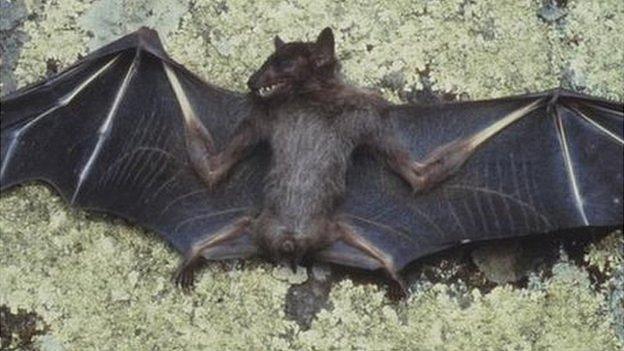
In one operation some bats burned down a hangar and a commanding officer's car
During World War Two, the US military came up with the idea of attaching small incendiary devices to whole colonies of bats, external, packing them in a crate and parachuting them over Japan.
Dubbed "Project X-Ray", when their crates opened, the intention was bats would take roost and - once they were blown up - fires would start simultaneously across cities.
However, at one point during testing, some bats got loose, resulting in a major fire at the US base. On another occasion some bats burned down a hangar and a commanding officer's car.
The US Navy spent $2m (£1.1m) after taking over the effort, but the final report issued in mid-1944 noted the bats would not be ready for combat for another year.

Record-breaking pigeons
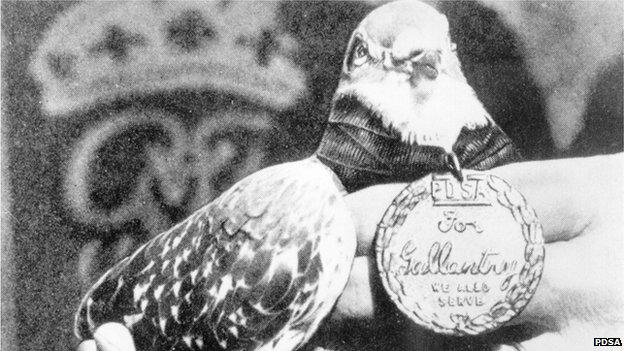
GI Joe was one of the 32 messenger pigeons to receive the PDSA Dickin Medal
GI Joe, external was credited with making the most outstanding flight by a US Army pigeon during World War Two.
During the month of October 1943, British troops were trying to advance on the German-held Italian town of Colvi Veccia and requested an aerial bombardment by their allies.
The German resistance fell and British soldiers took up positions inside the town but because the bombing was scheduled to take place within the half-hour, a panicked message was tied to the leg of GI Joe and sent to the headquarters.
As the bombers were taxiing the runways at headquarters, GI Joe arrived with the message to cancel the operation.
He had flown 20 miles in 20 minutes and his speedy delivery saved 150 British troops from disaster by less than five minutes.
His journey was recognised in August 1946 when he was given the PDSA Dicken Medal.

Cyborg beetles
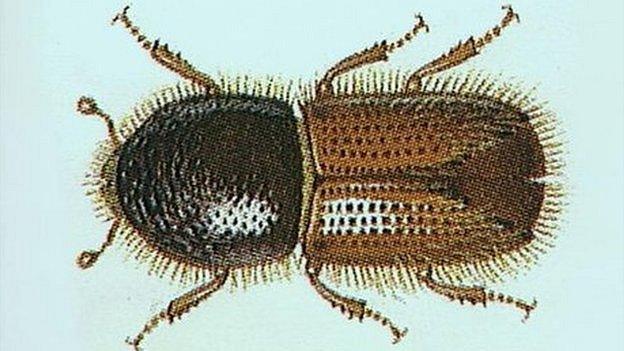
Beetles can act as batteries for their equipment
Researchers at the US military base - the Defense Advanced Research Projects Agency (Darpa) - have found that beetles can be fitted with video and audio equipment.
The aim is for the beetles, dubbed Micro-Air-Vehicles, to carry out spying missions with biofuel cells that run off their own bodies.
The beating of their wings recharges the batteries and some are apparently capable of poisonous injections and tiny embeddable GPS tags, external.

Dolphin spies
Dolphin spies, external have been serving the US Navy for more than 40 years in the Marine Mammal Program.
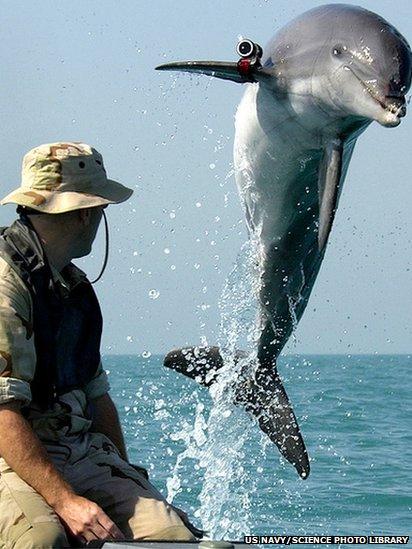
Dolphins have a transponder attached to their fins to show their location
The animals were used in the Vietnam War, Operation Iraqi Freedom, and the Ukraine.
A transponder attached to the pectoral fin allows handlers to track the dolphin's location.
The mammals are trained for underwater tasks including locating underwater mines, delivering equipment and locating objects.
In 2007 the US Navy said it needed to step up security at its Washington base, which is home to submarines, ships and laboratories, and considered vulnerable to offshore terrorist attacks.
After examining several options a group of bottlenose dolphins were picked in 2009 to patrol the area on the look out for swimmers or divers in the base's restricted waters.
The program also trains California sea lions, killer whales and beluga whales.

Fear-sniffing gerbils
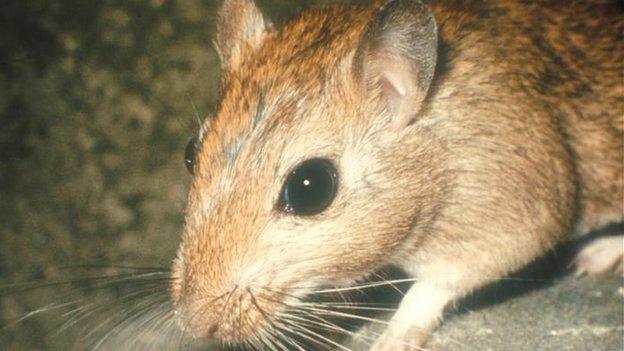
Gerbils could not identify the source of people's fear
Security Service MI5 planned to recruit a team of specially-trained gerbils, external to sniff out spies in the 1970s.
The aim was for the animals to help interrogators because they could use their acute sense of smell to detect a rise in adrenalin - the chemical released in sweat when people feel under stress.
However MI5 dropped the plans after it was discovered the gerbils could not tell the difference between terrorists and passengers who were scared of flying.
The security service's director general Sir Stephen Lander revealed the plan when he spoke at the launch of a new spy exhibition in London in 2001.

Night-vision glow worms
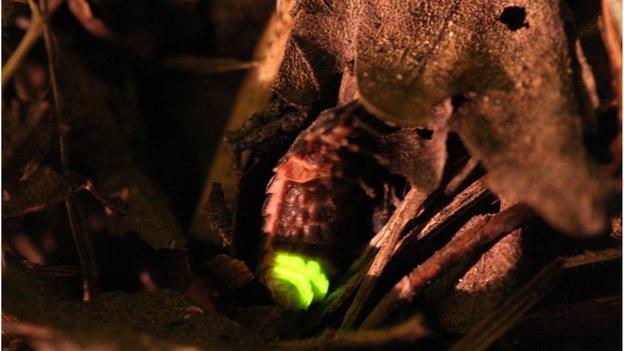
Glow worms were deployed so soldiers could read orders
During World War One glow worms, external were deployed by the British in the trenches.
Their tiny, glowing posteriors provided light so soldiers could read orders, maps and communications without being seen by the enemy.

Exploding-rats
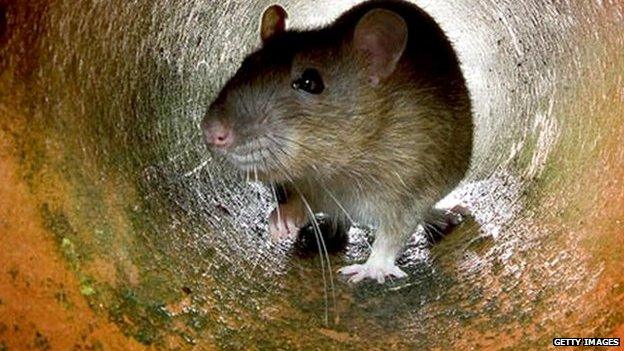
Dead rats were filled with explosives during World War Two
Dead rats were prepared for use by the British Special Operations Executive during World War Two.
Rat carcasses were filled with plastic explosives, to be left in factories where, it was hoped, the stoker tending a boiler would likely dispose of the unpleasant discovery by shovelling it into the furnace, causing it to explode.
However they were never used, as the first consignment was seized by the Germans and the secret was blown.

Rat-catching cat

Simon was aboard HMS Amethyst and was both friend and life-saver
Simon, the ship's cat, external aboard the HMS Amethyst, was both friend and life-saver during the Chinese Civil War Yangtze Incident of 1949.
HMS Amethyst was sent to Nanking, the Chinese capital, to deliver supplies to the British Embassy.
However the warship was held captive on the banks of the Yangtze River for 101 days, where Simon the cat distinguished himself by catching the rats that were eating their way through the ship's rations.
The ship made its escape down river in July 1949 and docked in her home port of Plymouth on 1 November 1949.
Simon was awarded the PDSA Dicken Medal posthumously in 1949.
- Published11 November 2013

- Published29 April 2014
